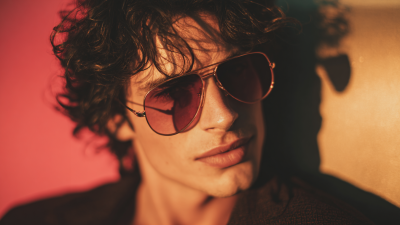In today's fast-paced world, the demand for versatile eyewear solutions has never been higher. According to the Vision Council's 2021 report, approximately 75% of adults in the United States require some form of vision correction, which has led to a growing interest in innovative eyewear options such as Clip-on Glasses. These practical attachments offer a seamless way to adapt existing prescription glasses for various lighting conditions and activities, from driving to outdoor sports. As a convenient alternative to traditional sunglasses, Clip-on Glasses provide not only functional benefits but also a cost-effective solution for consumers. In this ultimate guide, we will explore how to choose the perfect Clip-on Glasses to suit every lifestyle, ensuring that you can enjoy optimal comfort and style without compromising your vision needs.

When searching for the perfect clip-on glasses, understanding your prescription needs is crucial. Prescription requirements can vary significantly based on individual vision problems, such as myopia, hyperopia, astigmatism, or presbyopia. It’s essential to consult with an eye care professional to obtain an up-to-date prescription that reflects your current vision health. This ensures that your clip-on glasses will not only accommodate your visual needs but also enhance your overall comfort and clarity.
Tip: Always bring your prescription glasses to your eye care appointment. This allows the optometrist to determine the most suitable clip-on style and lens type based on your existing eyewear.
Additionally, consider your lifestyle when choosing clip-on glasses. If you are often outdoors, polarized lenses can eliminate glare and improve visibility. For those frequently switching between different lighting conditions, photochromic lenses that adjust to UV exposure can be a fantastic option.
Tip: Think about the activities you engage in daily to help guide your selection process. If you engage in sports or outdoor activities, durability and impact resistance should be a priority in your clip-on glasses.

When it comes to selecting clip-on glasses, understanding the various lens types available can greatly enhance your visual experience for different lifestyles. Polarized lenses, for instance, are particularly favored by outdoor enthusiasts. These lenses are engineered to minimize glare from surfaces like water, snow, and roads, which can be crucial for activities such as hiking or running. Recent data indicates that polarized lenses can improve visibility by up to 60%, making them an excellent choice for anyone who spends significant time outdoors.

Photochromic lenses, on the other hand, adapt to changing light conditions by darkening in bright sunlight and becoming clear in low light. This feature is invaluable for individuals transitioning between indoor and outdoor environments, ensuring optimal comfort and protection from harmful UV rays. Industry reports show that about 30% of users prefer photochromic lenses for their versatility, emphasizing their practicality for those with dynamic routines. Additionally, understanding these lens types helps in choosing the right fit, ensuring that your clip-on eyewear effectively meets your lifestyle needs while providing essential eye protection.
Choosing clip-on styles that match your daily activities requires a thoughtful approach to both functionality and aesthetics. With research from the Vision Council indicating that nearly 75% of adults require vision correction, clip-on glasses have emerged as a practical and stylish solution for various lifestyles. Whether you’re a student, a professional, or a parent, the right clip-on glasses can seamlessly transition from one activity to another, enhancing your vision while complementing your personal style.
For outdoor enthusiasts, polarized clip-on sunglasses are essential. According to a 2022 report by the American Optometric Association, glare from reflective surfaces can increase the risk of eye strain and discomfort. Thus, selecting clip-ons with appropriate UV protection and anti-glare features is crucial for those who spend time hiking, fishing, or enjoying beach activities.
Conversely, urban professionals may prioritize sleek designs that fit well with business attire. Options that provide blue light filtering, as highlighted in a survey by the Digital Eye Strain Report, can protect against digital screens, making them an excellent choice for extensive office work or gaming sessions.
Tailoring clip-on styles not only enhances eye protection but also elevates your overall daily experience.
When selecting clip-on glasses, the choice of materials significantly impacts both durability and comfort. According to a recent study by the Vision Council, nearly 70% of consumers prioritize comfort when choosing eyewear products. As such, materials such as polycarbonate and TR90 are increasingly favored for clip-on glasses. Polycarbonate, known for its high impact resistance, is up to 10 times more durable than traditional plastic lenses, making it an excellent choice for those with active lifestyles. Moreover, its lightweight nature ensures that wearers won't feel weighed down during extended use.
Comfort is further enhanced by using flexible materials like TR90, which not only offers resistance to heat and stress but also provides a superior fit that can adapt to various face shapes. The American Optometric Association emphasizes the importance of proper fitting eyewear, noting that ill-fitting glasses can lead to discomfort and even headaches. With these materials, wearers can enjoy a snug fit without compromising on style or performance, making them ideal for any lifestyle—from leisurely afternoons outdoors to the demands of a busy office environment.
When it comes to budgeting for clip-on glasses, understanding what to expect is crucial in making an informed decision. First and foremost, it’s important to know the different price ranges available in the market. Basic clip-on glasses can typically be found for as low as $20 to $50, while higher-end options, which may include custom lenses or advanced lens technology, can cost upwards of $100 to $300. Depending on your lifestyle and specific vision needs, it’s essential to find a balance between affordability and functionality.
In addition to the initial purchase price, consider potential additional costs. You may want to invest in a protective case or cleaning kit to ensure the longevity of your clip-ons. Furthermore, if you wear corrective lenses, consult with your eye care professional to determine if prescription clip-on glasses are necessary, as this may affect your overall budget. Ultimately, taking the time to research and evaluate your options can help you make a smart financial choice while finding the perfect clip-on glasses that fit seamlessly into your lifestyle.
| Lifestyle | Budget Range | Material | UV Protection | Weight |
|---|---|---|---|---|
| Active Lifestyle | $50 - $100 | Polycarbonate | Yes | Lightweight |
| Fashion Forward | $80 - $150 | Metal and Plastic | Yes | Medium |
| Budget-Conscious | $20 - $50 | Plastic | Limited | Lightweight |
| Professional Use | $100 - $200 | High-Quality Acetate | Yes | Medium |
| Casual Everyday | $30 - $80 | Mixed Materials | Yes | Lightweight |






